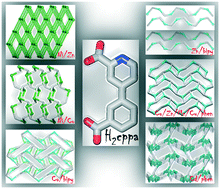Exploring 4-(3-carboxyphenyl)picolinic acid as a semirigid building block for the hydrothermal self-assembly of diverse metal–organic and supramolecular networks†
Abstract
4-(3-Carboxyphenyl)picolinic acid (H2cppa) was applied as a new and virtually unexplored building block for the synthesis of eleven new coordination compounds, namely [M(Hcppa)2(H2O)2]·2H2O {M = Ni (1) and Zn (2)}, [M(μ3-cppa)(H2O)2]n {M = Ni (3) and Co (4)}, {[Co(μ-cppa)(2,2′-bipy)(H2O)]·H2O}n (5), [Zn(μ-cppa)(2,2′-bipy)]n (6), [M(μ-cppa)(phen)(H2O)]n {M = Co (7), Zn (8), Mn (9), and Cu (10)}, and {[Cd3(μ3-cppa)3(phen)2]·4H2O}n (11). All these compounds were generated by a hydrothermal self-assembly method using the corresponding metal(II) chlorides, H2cppa, and two types of N-donor ancillary ligands, selected from 2,2′-bipyridine (2,2′-bipy) or 1,10-phenanthroline (phen). The obtained products 1–11 were characterized by standard methods, including IR spectroscopy, elemental and thermogravimetric analyses, and powder and single-crystal X-ray diffraction. They represent the first structurally characterized compounds derived from H2cppa. The structures of 1–11 vary from a complex 3D metal–organic framework (MOF) 11 to 2D coordination polymers 3 and 4, 1D coordination polymers 5–10, and discrete 0D monomers 1 and 2. Such a structural diversity is guided by the nature of the metal(II) node, level of deprotonation of 4-(3-carboxyphenyl)picolinic acid, and type of applied ancillary ligand. In addition, the structures of 1, 2, 5, and 7–10 are further extended [0D → 3D (1 and 2), 1D → 2D (5), and 1D → 3D (7–10)] into various H-bonded supramolecular networks. Both the supramolecular (in 1, 2, 5, and 7–10) and metal–organic (in 3, 4, 6, and 11) underlying networks were analyzed and classified from the topological viewpoint, revealing the distinct pcu (in 1 and 2), fes (in 3 and 4), gek1 (in 5), 2C1 (in 6), and srs (in 7–10) topological nets, whereas a topologically unique framework was identified in MOF 11. The magnetic behavior of 3–5, 7, 9, and 10 and luminescence properties of 2, 6, 8, and 11 were also investigated and discussed.



 Please wait while we load your content...
Please wait while we load your content...